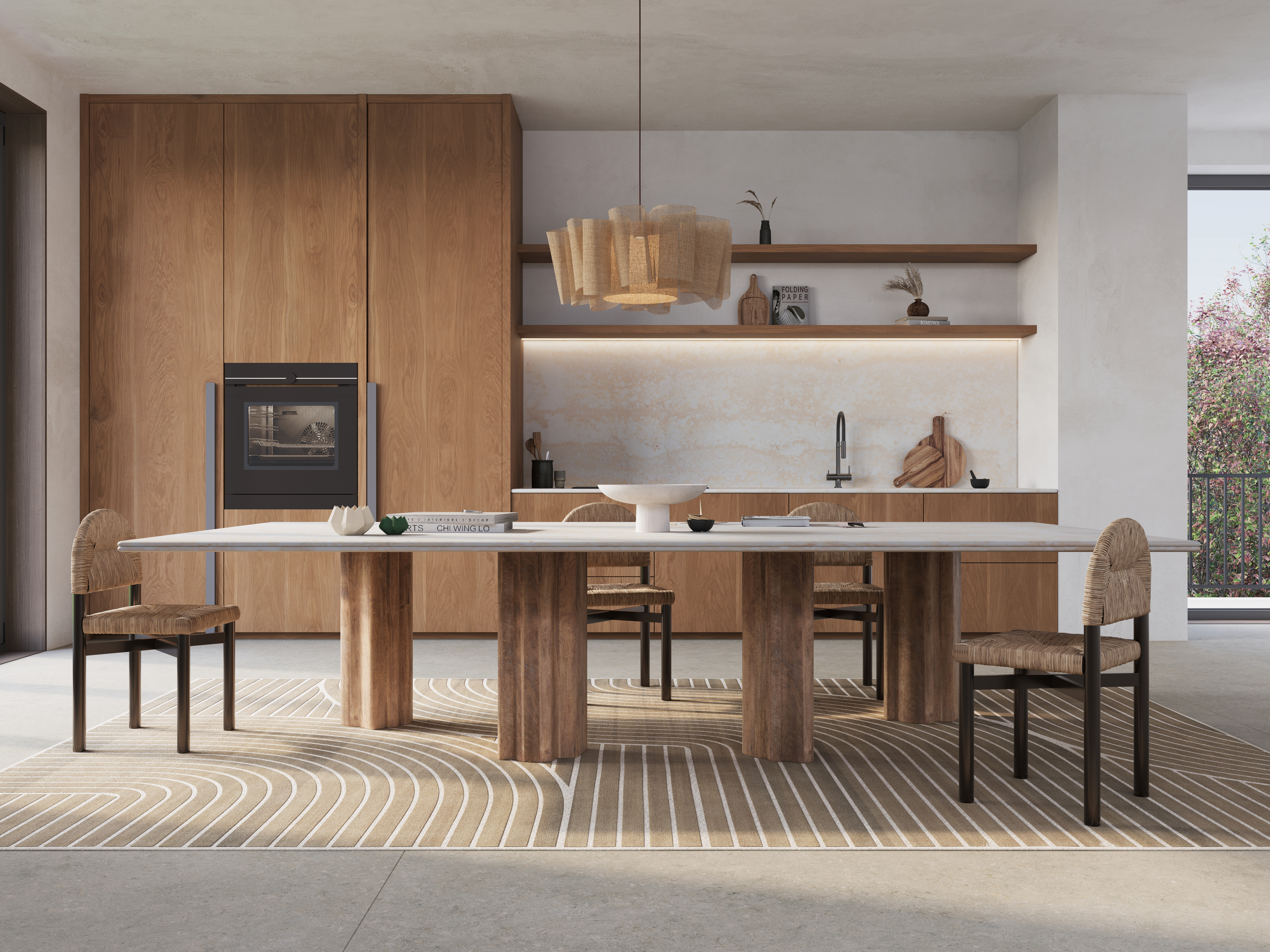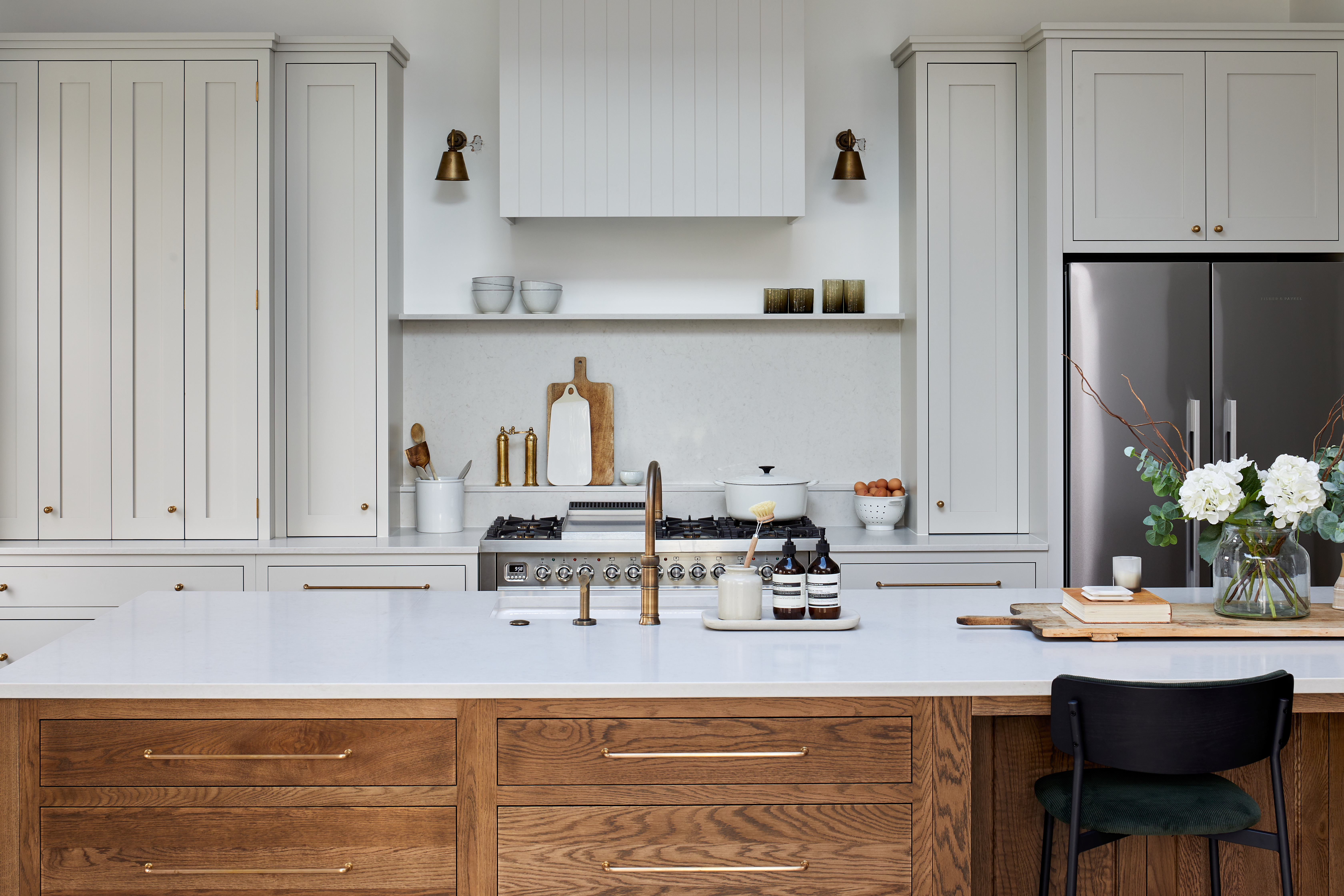Following the recent launch of their crystalline silica-free surface, ICON, I caught up with Caesarstone VP of Marketing, Jonathan Stanley, to discover more about the company’s unique position in the worktop industry. The brand is approaching its 40th year in business and has built a reputation for supplying premium engineered stone surfaces. With over 20 years of marketing and PR experience, Jonathan has helped steer the brand since 2016 and offered insights into the downfalls of specifying based on affordability alone, the importance of traceability, and how Caesarstone continues to stand out in a crowded market.
JB: With so many engineered stone companies on the market, particularly in the world of worktops, how do specifiers and consumers begin to distinguish between them?
JS: Of all the industries that I’ve ever worked in, the stone industry and particularly the engineered stone and porcelain sectors are the hardest to navigate from the outside. There are multiple material types and terms, and a wealth of misinformation, some of which is deliberate and some of which is just poor communications.
The silicosis debate over the past few years has at least caused designers, specifiers, and consumers to ask more questions, which is a good thing. However, during many briefing sessions over the last 24 months to discuss occupational health, material technology, and safer working practices, often with large architectural firms, I’ve been staggered at how little understanding there often is.
As with ANY product category, there is good, bad, and the downright ugly. Why would our sector be any different? The good news is that it can be ridiculously easy to determine which is which. Whether consumer or trade pro, start with the website and check available product information and certification. Can you find a Safety Data Sheet that explains everything about the product? Is there technical information that shows how to safely work with the material? Is there evidence of an ESG programme or other environmental information?
Good brands will have multiple case studies. Are these in line with what you are looking for or aspiring to? Finally, does the product actually look any good? Sadly, there are some cheap materials on the market that are very poorly designed. One could laugh, if they didn’t reflect so poorly on the rest of the stone industry.

JB: So, how does Caesarstone continue to differentiate itself from the market when so many products have come along that look like your surfaces?
JS: On the surface, many of these materials look similar, but what sits behind them in terms of quality, safety, and accountability is where the true value is found. The market is driven by price, and has been engaged in a race to the bottom for a number of years. This can mean compromises in raw materials, inconsistent quality, and little to no traceability of where and how the product was made. That’s why a “bargain” worktop can quickly become a false economy.
Caesarstone has been designing, manufacturing, and sourcing engineered stone for nearly 40 years. We were the pioneers of engineered stone, bringing it to market, and the first to achieve genuinely natural-looking designs and concrete-inspired surfaces that changed the way people think about worktops. Every slab is designed and manufactured with meticulous care, using only the highest-grade raw materials and processes that meet the strictest international standards. We back our worktops with a lifetime warranty, rigorous testing, and complete transparency of product performance and environmental credentials because a worktop isn’t just a surface; it’s the foundation of your kitchen.
When you consider that the average kitchen lasts 15–20 years, the difference between choosing a trusted brand like Caesarstone and an unbranded alternative can be surprisingly small – often less than £100 a year across the kitchen’s lifespan. In return, you gain a surface that’s beautiful, durable, safe, and backed by a company that stands behind every slab. That’s what makes Caesarstone truly premium.

JB: But of course, there are also a plethora of cheap worktops available on the market, which they arguably dominate. Is it a case of getting what you pay for, and if so, what is the impact of buying based on affordability alone? Presumably, there are hidden costs that outweigh the initial price tag of a premium surface?
JS: It’s tempting to focus on affordability when choosing a worktop, but in reality, a cheap option is cheap for a reason, and usually carries hidden costs. Lower-grade materials can compromise on safety, with little clarity on how or where they were manufactured. They may lack the durability needed for daily use, meaning chips, stains, or cracks appear sooner, and repairs or even full replacements become inevitable. And without environmental credentials or traceability, they can carry a far greater impact on the planet than many consumers realise.
Cheap materials are often associated with poor fabrication practices, which has an impact on the occupational health and wellbeing of those in our industry too.
On the other hand, a premium surface like Caesarstone is designed to last the full lifespan of the average kitchen, and beyond. Because we continue to innovate - most recently with ICON, our crystalline silica-free surfaces – specifiers and consumers can be confident they’re choosing not only a durable material, but also one that reflects the latest advances in aesthetics, performance, and safety.
When you look at the real cost per year, the difference is surprisingly small, but the benefits are profound: peace of mind on safety, a lifetime warranty, assured durability, and the knowledge that your worktop was responsibly made to the highest global standards. Affordability in the moment can come at a high price over time, whereas investing in quality ensures lasting performance, beauty, and integrity.

JB: In terms of costs, there is also the grey area of the installed cost of worktops, which can itself be a bit of a minefield. Do you have any useful tips or insights to help consumers decode the installed cost of a worktop and spot if corners are being cut?
JS: Decoding the installed cost of a worktop isn’t always straightforward, but there are a few key points consumers and specifiers can watch out for to ensure quality isn’t being compromised. Often, corners are cut during sourcing, fabrication, or installation, particularly when materials are chosen solely on price. This can show up as lower-grade slabs, inconsistent colour or veining, simplified edge profiles, or rushed installation, all of which affect durability, performance, and longevity.
To spot these issues, it’s important to understand what contributes to the final cost. Factors include the material itself, slab size, pattern complexity, edge profiles, and professional installation. If a quote seems unusually low, it’s worth asking exactly what’s included, how the slabs are sourced, and whether the installer is accredited. Unbranded or very cheap surfaces usually carry hidden risks: poor durability, substandard safety compliance, and lack of traceability, which can result in unexpected repairs or replacement costs down the line.
When it comes to manufacturers, be wary of products with no identifiable brand, no website, no clear country of origin, and no third-party testing or certification. If a supplier can’t provide certifications, a warranty, or evidence of performance testing, that’s a red flag. Another tell-tale sign is a lack of contact details for after-sales service. Once the invoice is paid, you should still have a reliable support network in place for years to come. Also, look at the fabrication process: reputable partners will work with fabricators who follow best-practice safety measures and produce a consistent, high-quality product. If those safeguards aren’t visible, they might not be happening. And don’t hesitate to contact a brand’s customer service team to request further product information, recommended fabricators, and ask questions. Transparent businesses will welcome the opportunity to provide clear answers and demonstrate their standards.

JB: That underlines the importance of transparency to all forms of specifiers when it comes to material sourcing and manufacturing. What is Caesarstone’s approach here, has this evolved in recent times?
JS: Transparency has always been central to Caesarstone. Choosing a worktop isn’t just about aesthetics; it’s about trust in where the material comes from, how it was made, and how it will perform over time. We provide full traceability and verifiable data through rigorous testing, third-party verified ESG reports, environmental product declarations, and international certifications, so specifiers can make informed decisions with complete confidence. And as we expand the ICON portfolio, we’re committed to backing it with the same level of third-party declarations and certifications, setting new standards of transparency in the category.
Throw into the mix Caesarstone’s Masters of Stone programme – free health & safety training for anyone working in the stone industry, whether you are a customer of ours or not. Caesarstone believes in adding value back into the industry and making it attractive for the next generation of stone masons and fabricators.
Alongside this, we’ve evolved our approach to support the industry more directly – introducing clear, competitive pricing structures (including this year’s reductions on some of our best-selling surfaces), as well as tailored educational material and hands-on guidance for designers, housebuilders, developers, and fabricators. Our dedicated customer service team works closely with partners at every stage, ensuring not only product transparency, but also project clarity and peace of mind.

JB: The company certainly stands out from the crowd in terms of its branding, something I’m sure you and your team have worked hard on. Your explicit material traceability and certification are a big part of that messaging. Can you talk me through the rationale here?
JS: Some industry people will tell you that Caesarstone is more expensive because we have to pay for all of our marketing, and often, I wish we had the marketing budgets that many think we have.
We spend a lot on raw materials, manufacturing expertise, design research and testing and certification, and, ultimately, this approach is the Caesarstone brand. We are an inherently curious, R&D-led business, and our primary interest is in making the best product that we can.
The Caesarstone brand stands out because we are mostly showing off what are very well-designed products. These are then elevated further because the products are mostly seen in very well-designed spaces. If you are lucky enough to be continually specified by some of the best kitchen, interior, or architectural designers around the world, when you show a case study, people notice.
Our branding, for us, has always been about more than visual identity; it’s based on trust and the story behind every surface we produce. Explicit material traceability and certification are central to that story. They allow us to show specifiers, designers and homeowners exactly where our raw materials come from, how they are processed, and the rigorous standards they meet along the way.
This level of transparency underpins our premium positioning. It’s what differentiates Caesarstone in a crowded market, where many materials may look similar but don’t offer the same assurances of quality, safety and sustainability. By making this information clear and verifiable, we’re not just selling a surface; we’re giving confidence in every decision, reinforcing the integrity of our brand, and demonstrating that premium engineered stone isn’t just a claim, it’s a commitment.